When it comes to feeding your baby, every parent’s goal is the same: providing meals that are nutritious, safe, and delicious. In the early years of life, the foods you choose can have a big impact on your child’s growth, immune system, and relationship with food. That’s why baby-friendly meals made from natural ingredients — free from artificial additives, refined sugars, and unnecessary processing — are the gold standard for healthy development.

Why Natural Ingredients Matter for Babies
1. Nutrient Density
Natural ingredients like fresh vegetables, fruits, whole grains, and lean proteins offer essential vitamins and minerals without added chemicals. Babies need nutrient-dense foods to support rapid growth and brain development.
2. Fewer Allergens and Additives
By sticking to whole, natural foods, you can more easily control what your baby consumes — reducing the risk of allergic reactions, digestive upset, and unnecessary exposure to preservatives.
3. Encourages Healthy Eating Habits
Early exposure to a variety of whole foods can shape your child’s taste preferences, helping them appreciate the natural flavors of fruits, vegetables, and whole grains instead of overly processed snacks.
Starting Solids: The Basics
When introducing solids (usually around 6 months, as per pediatric guidance), your baby’s meals should be:
- Soft and smooth to avoid choking hazards
- Low in salt and sugar
- Iron-rich, especially if breastfeeding exclusively
- Allergen-aware, introducing common allergens slowly
Texture progression:
- 6–8 months: smooth purees, single-ingredient foods
- 8–10 months: thicker purees, soft mashed foods
- 10–12 months: small soft chunks, finger foods
Seasonal Vegetables for Baby Meals
Eating seasonally ensures your baby gets the freshest produce with peak nutrition. Here are some examples:
| Season | Baby-Friendly Veggies |
|---|---|
| Spring | Peas, carrots, zucchini, asparagus |
| Summer | Sweetcorn, green beans, pumpkin, capsicum |
| Autumn | Sweet potato, spinach, cauliflower, broccoli |
| Winter | Butternut squash, kale, parsnips, beetroot |
Dairy-Free and Gluten-Free Baby Meals
For babies with allergies, intolerances, or family dietary preferences, there are plenty of safe, nutritious options.
- Dairy-Free: Use coconut milk, oat milk, or breastmilk/formula for creaminess in purees.
- Gluten-Free: Use quinoa, millet, or rice instead of wheat-based grains.
Baby Meal Planning Tips
- Batch cook and freeze: Steam and puree seasonal vegetables, then freeze in small portions.
- Introduce one new food at a time: This helps identify any allergies.
- Blend flavors gradually: Start with single ingredients, then combine for variety.
- Mind the texture: Adapt meals as your baby grows — from smooth purees to finger foods.
Recipes – Baby-Friendly and Naturally Nutritious
1. Sweet Potato and Carrot Puree (6+ Months)
Ingredients:
- 1 medium sweet potato, peeled and diced
- 2 carrots, peeled and diced
- Water or breastmilk/formula for blending
Method:
- Steam sweet potato and carrots until soft (about 15 minutes).
- Transfer to a blender, add a splash of water or milk, and puree until smooth.
- Cool before serving.
2. Pea and Zucchini Mash (7+ Months)
Ingredients:
- 1 cup peas (fresh or frozen)
- 1 zucchini, chopped
- 1 tsp olive oil
Method:
- Steam peas and zucchini until tender.
- Mash with a fork or blend for a smoother texture.
- Stir in olive oil for healthy fats.
3. Quinoa, Apple, and Pumpkin Porridge (8+ Months)
Ingredients:
- ¼ cup quinoa, rinsed
- ½ cup pumpkin, peeled and diced
- ½ apple, peeled and diced
- 1 cup water
Method:
- In a small pot, cook quinoa, pumpkin, and apple in water until soft.
- Blend for a smooth puree or mash for a chunkier texture.
4. Broccoli and Cauliflower Purée with Coconut Milk (8+ Months)
Ingredients:
- ½ cup broccoli florets
- ½ cup cauliflower florets
- 2 tbsp coconut milk
Method:
- Steam broccoli and cauliflower until tender.
- Blend with coconut milk until smooth.
5. Lentil and Sweet Potato Stew (10+ Months)
Ingredients:
- ½ cup red lentils
- 1 small sweet potato, diced
- 1 carrot, diced
- 2 cups water
Method:
- Simmer all ingredients together until lentils and vegetables are soft.
- Mash or blend to desired texture.
6. Finger Food: Steamed Veggie Sticks (10–12 Months)
Ingredients:
- Carrot, zucchini, sweet potato – cut into sticks
Method:
- Steam until soft enough to mash between fingers.
- Serve as a snack or side.
Nutrient Focus: Key Ingredients for Baby Growth
| Ingredient | Benefits |
|---|---|
| Sweet Potato | Rich in beta-carotene for vision and immunity |
| Lentils | High in plant-based protein and iron |
| Broccoli | Packed with vitamin C and calcium |
| Quinoa | Complete protein and gluten-free |
| Apple | Natural sweetness, vitamin C, fiber |
| Coconut Milk | Healthy fats for brain development |
Safety & Storage
- Always let food cool before feeding your baby.
- Store purees in airtight containers in the fridge for up to 48 hours or freeze for up to 3 months.
- Reheat gently, avoiding microwaving directly in plastic.
Conclusion
Feeding your baby doesn’t need to be complicated. With natural, seasonal ingredients, you can create a variety of wholesome meals that nurture their growth and encourage healthy eating habits for life. Whether you’re steaming fresh veggies, blending creamy purees, or serving soft finger foods, the key is to keep it fresh, safe, and full of flavor.
Leave a comment
Your email address will not be published. Required fields are marked *




















